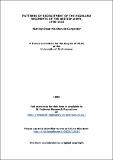Patterns of recruitment of the Highland regiments of the British Army, 1756-1815
Abstract
In the years following the military defeat of Jacobitism in 1746 and the legal destruction of the Highland clan system, the Highlands of Scotland provided many thousands of troops for service in the British army and especially in the numerous Highland corps, both Fencible and regular of line as well as Volunteer and Militia, which were raised after 1756.
Although other Highland corps, the Argyleshire Highlanders raised in 1689, the Black Watch composed of the amalgamated Independent Companies in 1739 and Loudon’s Highlanders embodied in 1745, had been raised prior to 1756, the great fear of Jacobite activity and of arming the Highlanders on the part of the English political nation, prevented the extensive use of Highlanders in the British army throughout the first half of the 18th century. With the renewal of war with France in 1756, however, the need for troops was crucial. William Pitt the Elder succeeded in persuading the Cabinet and King George of the great advantages of employing Highlanders in army service. Not only did this action remove the disaffected Highlanders from the country and employed them against the foreign enemies, the policy opened up a storehouse of willing, aggressive, loyal and first-rate troops for the wars of the 18th and early 19th centuries.
Thousands of Highlanders enlisted in the Highland regiments and as many as 100,000 men served from 1793 to 1815, a figure out of proportion to the population of the region in the 18th century. Not only the pressures of a rapidly rising population and unemployment, but also the appeals to clan loyalty and duty to one’s superior served to bring out the Highlanders in great numbers. The area of heaviest recruitment proved to be the northwest Highlands and Islands where the pressures of population and unemployment were most heavily felt. This region was also the most conservative and traditional, a phenomenon brought about by the relative isolation from the modernizing influences of Lowland Scotland.
The over-recruiting of the Highlands, especially after 1800, led to the eventual collapse of Highland recruiting. Not only was the surplus manpower severely drained, but appeals to clan loyalty had diminished in strength, especially under the impact of a changing economy and the growing alienation of clan chieftains to their tenants and the erosion of the patriarchal social system.
Several factors were of importance to the patterns of the recruitment of the Highland regiments such as the matter of financial arrangements. Bounties became increasingly important as the recruiting efforts began to falter. The growing dependence on non-Highlanders, particularly Lowlanders and Irish, clearly indicates the breakdown of Highland recruiting. This thesis, then, examines in detail these major themes and patterns of recruiting for the Highland regiments from the beginning of the Seven Years’ War to the final defeat of Napoleonic France in 1815.
Type
Thesis, MLitt Master of Letters
Collections
Items in the St Andrews Research Repository are protected by copyright, with all rights reserved, unless otherwise indicated.

